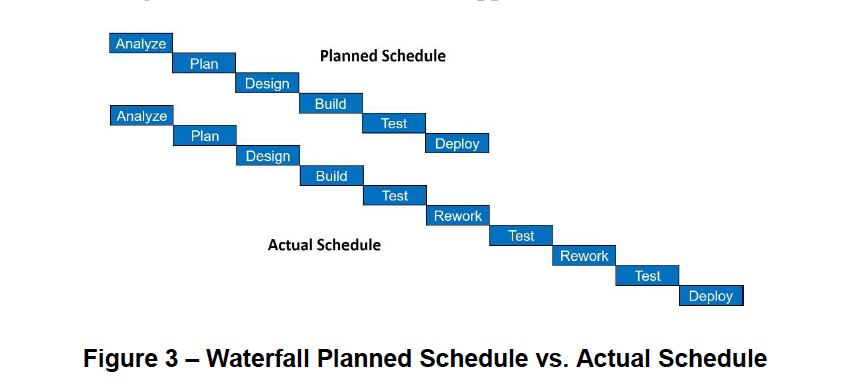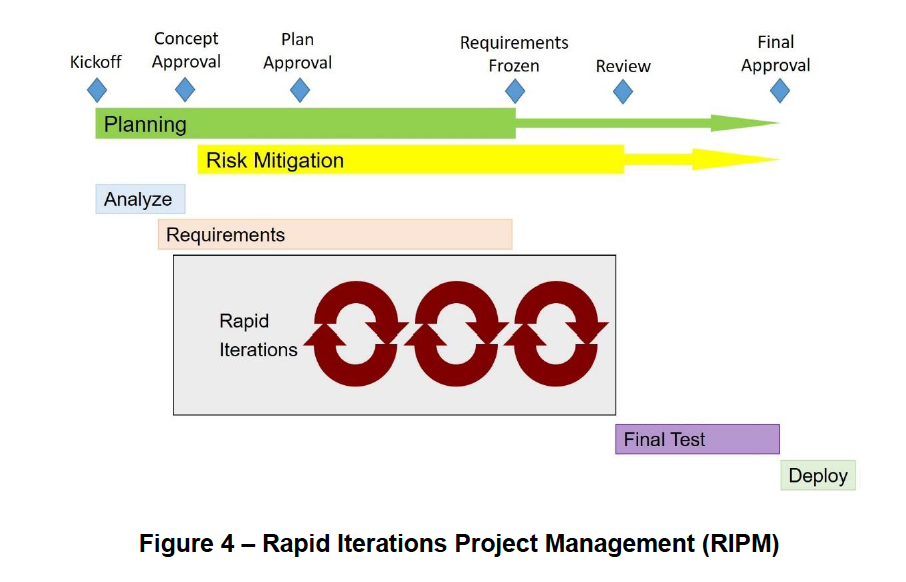The cost of delay on technical projects averages tens of thousands of dollars per day in lost profit. This briefing describes a project management approach called Rapid Iterations Project Management (RIPM), which is optimized for speed and efficiency with the assumption that project requirements will be changing for a period of time. RIPM utilizes elements of Agile, Lean, Kanban and general project management best practices combined – yielding an optimal methodology for rapid development with changing requirements.
Project delay factors are first explained; followed by an overview of Agile and Waterfall methodologies; then, an explanation and benefits of the RIPM approach.
Project Delay Factors
With the cost of delay averaging tens of thousands per day, the benefit of finishing sooner is substantial. Engineers accredit project delays to three main factors:
1. Changing requirements
2. Inadequate planning
3. Interruptions
Changing requirements and interruptions are real-world conditions that are very difficult to eliminate. Inadequate planning is easily eliminated. With the right planning approach, changing requirements and interruptions can be minimized as delay factors.
Emphasis must be on project planning to complete projects faster and reap the significant financial gains. The RIPM approach, when executed well, helps to complete projects as quickly and efficiently as possible, with the requirements being a moving target.
Two general models for planning and executing projects are most widely used:
1. Waterfall – The conventional project management approach used by most companies that have a structured process for projects. The basic philosophy is that after analyzing a project opportunity, a comprehensive plan is completed up front and approved by management. The team then executes in phases according to plan.
2. Agile – Many iterations (commonly called sprints) of assessing new requirements (discovery), planning work (design), developing a work product to complete requirements, and testing to verify that the requirements are met. The main benefit of the Agile approach is flexibility to incorporate new requirements throughout the project lifecycle.
Waterfall and Agile both have major advantages and disadvantages, and there is much debate about which approach is better. Neither approach on its own is optimized for rapid development and efficiency, with changing requirements.
One of the most significant drawbacks of Waterfall is that complexity is not usually managed well. Typically a large amount of complex work is developed and integrated, then several iterations of testing and rework are often required. These iterations cause delays, and defects can slip through the cracks because too much complexity is dealt with by team members doing big chunks of work. Figure 3 illustrates what often happens.
The Agile approach is superior in this regard because a large amount of work is never completed before testing and correcting problems. The end work product has the same complexity as if it was done using the Waterfall approach, but with Agile, each iteration of work product is small, well-understood, and tested. Agile is a much better way to manage complexity and potentially have a product with fewer defects than with the Waterfall approach.
A common Agile/Scrum process is to minimize up-front planning and iterate until a releasable product is ready. Most project teams don’t have the luxury of iterating indefinitely, so this approach doesn’t work for teams with challenging deadlines and limited budgets.
RIPM
Rapid Iterations Project Management (RIPM™) takes the Agile approach to a more advanced level than the common Scrum implementation, so it can be applied to non-software projects involving disciplines such as mechanical, electronic, and optical engineering. RIPM involves an intensive planning approach at the start of the project for achieving challenging timelines and handling changing requirements.
The RIPM approach utilizes elements of Agile and Lean philosophies; Scrum and Kanban methodologies; and general project management best practices – optimized for speed and efficiency. RIPM can be implemented within the framework of many existing processes.
The milestones at the top of the diagram in Figure 4 are management involvement points. Most of these milestones are typical in a stage-gate process. The RIPM planning phase is similar to Waterfall planning, but even more intensive up front to determine the rapid iteration strategy (number of iterations, duration of iterations, requirements breakdown, test strategy, requirement freeze plan, etc.).
Risk mitigation needs to be exceptional to be successful with RIPM, because the objective is to complete the project as quickly as possible with exceptionally high quality and efficiency. Schedule risks, quality risks and cost risks must be identified using best practices such as risk brainstorming and risk prioritization.
Scrum and Kanban methods are recommended using RIPM, to keep stakeholders engaged and informed throughout the project lifecycle. Figure 5 shows the phases of each iteration, which are similar to Scrum/Agile sprints.
Since RIPM can be applied to many types of projects, the objective at the end of the iteration is not “working code” as it is in software development. The objective is to implement the planned requirements and verify that they are met. Standard Agile sprints are one or two weeks. Using RIPM, iterations can vary and be whatever timeframe is needed to incorporate the planned requirements. The up-front planning should target between one and eight weeks per iteration as a guideline.
Iterations greater than eight weeks in duration should be avoided, in order to minimize the complexity of the work implemented before testing.
The major disadvantage of the RIPM approach is that it requires greater planning, management and teamwork skill than Agile/Scrum or Waterfall methodology. Team leaders and team members need to develop new skills to be successful with RIPM. Those skills involve a combination of education and experience using the methodology. It takes experience to know how many iterations to plan, the duration of the iterations, how to break down requirements, and to determine a strategy for verifying requirements in each iteration.
About Auxilium
Founded in 2002 by lead consultant Gary Hinkle, Auxilium helps engineering-oriented businesses increase productivity, manage special projects, and develop talent. Call or text Gary Hinkle directly at 971-222-6234 or email: gary@auxilium-inc.com to learn more about RIPM and consulting services offered by Auxilium.







